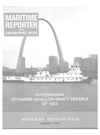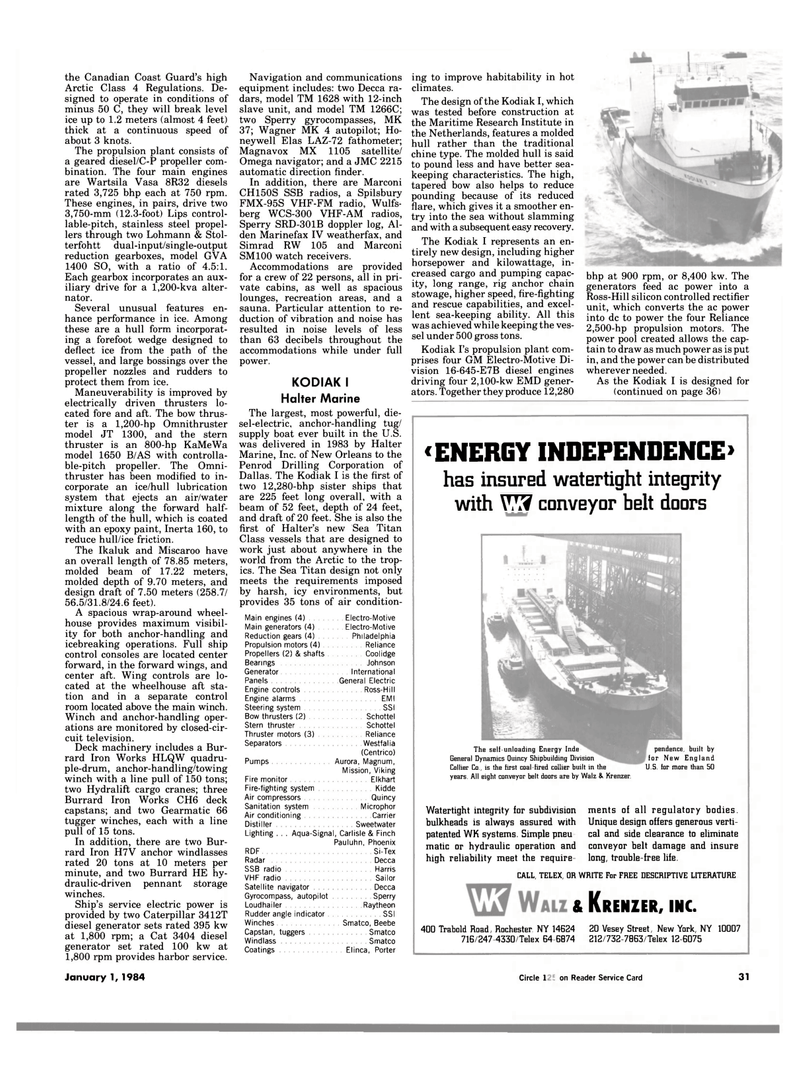
Page 31: of Maritime Reporter Magazine (January 1984)
Read this page in Pdf, Flash or Html5 edition of January 1984 Maritime Reporter Magazine
the Canadian Coast Guard's high
Arctic Class 4 Regulations. De- signed to operate in conditions of minus 50 C, they will break level ice up to 1.2 meters (almost 4 feet) thick at a continuous speed of about 3 knots.
The propulsion plant consists of a geared diesel/C-P propeller com- bination. The four main engines are Wartsila Vasa 8R32 diesels rated 3,725 bhp each at 750 rpm.
These engines, in pairs, drive two 3,750-mm (12.3-foot) Lips control- lable-pitch, stainless steel propel- lers through two Lohmann & Stol- terfohtt dual-input/single-output reduction gearboxes, model GVA 1400 SO, with a ratio of 4.5:1.
Each gearbox incorporates an aux- iliary drive for a 1,200-kva alter- nator.
Several unusual features en- hance performance in ice. Among these are a hull form incorporat- ing a forefoot wedge designed to deflect ice from the path of the vessel, and large bossings over the propeller nozzles and rudders to protect them from ice.
Maneuverability is improved by electrically driven thrusters lo- cated fore and aft. The bow thrus- ter is a 1,200-hp Omnithruster model JT 1300, and the stern thruster is an 800-hp KaMeWa model 1650 B/AS with controlla- ble-pitch propeller. The Omni- thruster has been modified to in- corporate an ice/hull lubrication system that ejects an air/water mixture along the forward half- length of the hull, which is coated with an epoxy paint, Inerta 160, to reduce hull/ice friction.
The Ikaluk and Miscaroo have an overall length of 78.85 meters, molded beam of 17.22 meters, molded depth of 9.70 meters, and design draft of 7.50 meters (258.7/ 56.5/31.8/24.6 feet).
A spacious wrap-around wheel- house provides maximum visibil- ity for both anchor-handling and icebreaking operations. Full ship control consoles are located center forward, in the forward wings, and center aft. Wing controls are lo- cated at the wheelhouse aft sta- tion and in a separate control room located above the main winch.
Winch and anchor-handling oper- ations are monitored by closed-cir- cuit television.
Deck machinery includes a Bur- rard Iron Works HLQW quadru- ple-drum, anchor-handling/towing winch with a line pull of 150 tons; two Hydralift cargo cranes; three
Burrard Iron Works CH6 deck capstans; and two Gearmatic 66 tugger winches, each with a line pull of 15 tons.
In addition, there are two Bur- rard Iron H7V anchor windlasses rated 20 tons at 10 meters per minute, and two Burrard HE hy- draulic-driven pennant storage winches.
Ship's service electric power is provided by two Caterpillar 3412T diesel generator sets rated 395 kw at 1,800 rpm; a Cat 3404 diesel generator set rated 100 kw at 1,800 rpm provides harbor service.
Navigation and communications equipment includes: two Decca ra- dars, model TM 1628 with 12-inch slave unit, and model TM 1266C; two Sperry gyrocompasses, MK 37; Wagner MK 4 autopilot; Ho- neywell Elas LAZ-72 fathometer;
Magnavox MX 1105 satellite/
Omega navigator; and a JMC 2215 automatic direction finder.
In addition, there are Marconi
CH150S SSB radios, a Spilsbury
FMX-95S VHF-FM radio, Wulfs- berg WCS-300 VHF-AM radios,
Sperry SRD-301B doppler log, Al- den Marinefax IV weatherfax, and
Simrad RW 105 and Marconi
SM100 watch receivers.
Accommodations are provided for a crew of 22 persons, all in pri- vate cabins, as well as spacious lounges, recreation areas, and a sauna. Particular attention to re- duction of vibration and noise has resulted in noise levels of less than 63 decibels throughout the accommodations while under full power.
KODIAK I
Halter Marine
The largest, most powerful, die- sel-electric, anchor-handling tug/ supply boat ever built in the U.S. was delivered in 1983 by Halter
Marine, Inc. of New Orleans to the
Penrod Drilling Corporation of
Dallas. The Kodiak I is the first of two 12,280-bhp sister ships that are 225 feet long overall, with a beam of 52 feet, depth of 24 feet, and draft of 20 feet. She is also the first of Halter's new Sea Titan
Class vessels that are designed to work just about anywhere in the world from the Arctic to the trop- ics. The Sea Titan design not only meets the requirements imposed by harsh, icy environments, but provides 35 tons of air condition-
Main engines (4) Electro-Motive
Main generators (4) Electro-Motive
Reduction gears (4) Philadelphia
Propulsion motors (4) Reliance
Propellers (2) & shafts Coolidge
Bearings Johnson
Generator International
Panels General Electric
Engine controls Ross-Hill
Engine alarms EMI
Steering system SS
Bow thrusters (2) Schottel
Stern thruster Schotte
Thruster motors (3) Reliance
Separators Westfalia (Centrico)
Pumps Aurora, Magnum,
Mission, Viking
Fire monitor Elkhart
Fire-fighting system Kidde
Air compressors Quincy
Sanitation system Microphor
Air conditioning Carrie
Distiller Sweetwater
Lighting . . . Aqua-Signal, Carlisle & Finch
Pauluhn, Phoenix
RDF Si-Te
Radar Decca
SSB radio Harris
VHF radio Sailor
Satellite navigator Decca
Gyrocompass, autopilot Sperry
Loudhailer Raytheon
Rudder angle indicator SSI
Winches Smatco, Beebe
Capstan, tuggers Smatco
Windlass Smatc
Coatings Elinca, Porter ing to improve habitability in hot climates.
The design of the Kodiak I, which was tested before construction at the Maritime Research Institute in the Netherlands, features a molded hull rather than the traditional chine type. The molded hull is said to pound less and have better sea- keeping characteristics. The high, tapered bow also helps to reduce pounding because of its reduced flare, which gives it a smoother en- try into the sea without slamming and with a subsequent easy recovery.
The Kodiak I represents an en- tirely new design, including higher horsepower and kilowattage, in- creased cargo and pumping capac- ity, long range, rig anchor chain stowage, higher speed, fire-fighting and rescue capabilities, and excel- lent sea-keeping ability. All this was achieved while keeping the ves- sel under 500 gross tons.
Kodiak I's propulsion plant com- prises four GM Electro-Motive Di- vision 16-645-E7B diesel engines driving four 2,100-kw EMD gener- ators. Together they produce 12,280 bhp at 900 rpm, or 8,400 kw. The generators feed ac power into a
Ross-Hill silicon controlled rectifier unit, which converts the ac power into dc to power the four Reliance 2,500-hp propulsion motors. The power pool created allows the cap- tain to draw as much power as is put in, and the power can be distributed wherever needed.
As the Kodiak I is designed for (continued on page 36) € ENERGY INDEPENDENCE > has insured watertight integrity with conveyor belt doors
CALL, TELEX, OR WRITE For FREE DESCRIPTIVE LITERATURE & KRENZER, INC. 400 Trabald Road, Rochester NY 14624 20 Vesey Street, New York, NY 10007 716/247-4330/Telex 64-6874 212/732 7863/Telex 12 6075
Watertight integrity far subdivision bulkheads is always assured with patented WK systems. Simple pneu matic or hydraulic operation and high reliability meet the require- ments of all regulatory bodies.
Unique design offers generous verti- cal and side clearance to eliminate conveyor belt damage and insure long, trouble-free life.
The self-unloading Energy Inde
General Dynamics Quincy Shipbuilding Division
Collier Co., is the first coal fired collier built in the years. All eight conveyor belt doors are by Walz & Krenzer. pendence, built by for New England
U S for more than 50
January 1, 1984 Circle 136 on Reader Service Card 31

 30
30

 32
32
